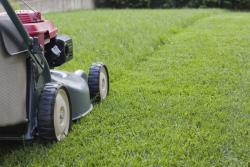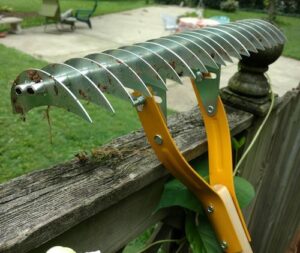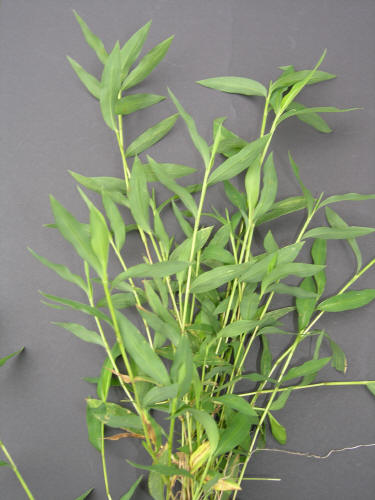A Practical Approach to Dealing with Lawn Weeds
by Brian Lathrop, Fairfax Master Gardener
Lawn weeds are inevitable in our cool-season grass turfs. Virginia is part of a ‘transition zone,’ where neither cool nor warm season grasses are completely adapted. Summers tend to be too hot for cool season turfgrass to do well. My lawn, for example, is infested with 26 of the 30 weeds listed on our Home Turf link and even two weeds that are not listed.
 Cultural practices that keep lawns healthy are crucial to minimizing weed infestation. Soil health, however, is sensitive to biological and environmental disturbances of all types. Heavy rains after a drought, for example, can rapidly affect the complex interactions among the biological components of soil. So, we should not expect cultural practices alone to keep our turfs healthy — some weed removal will be necessary.
Cultural practices that keep lawns healthy are crucial to minimizing weed infestation. Soil health, however, is sensitive to biological and environmental disturbances of all types. Heavy rains after a drought, for example, can rapidly affect the complex interactions among the biological components of soil. So, we should not expect cultural practices alone to keep our turfs healthy — some weed removal will be necessary.
Deciding between two weed removal strategies
When homeowners do need to remove weeds, we must decide between two general strategies: herbicide treatment or mechanical removal. Each strategy likely will have to be applied over a period of years until the lawn in sufficiently healthy and dense to prevent reinfestation. How should homeowners choose between these two strategies?
An overreliance on chemical control can result in resistance to pesticides, outbreaks of other pests and potential harm to non-target organisms. Further, as knowledge of the complex soil ecosystem improves, we find more examples of the ‘law of unintended consequences.’ Homeowners justifiably may be reluctant to use prolonged herbicide treatments out of a concern for unanticipated consequences to soil health, even when herbicides are used in accordance with the label.
The obvious problem with mechanical removal, on the other hand, is that extensive weed coverage necessitates considerable physical exertion. Further, the timing of weed removal is critical. Newly germinated top seeded varieties are at risk of frosts or droughts, so weeds should be removed before either event is likely. That means you likely will be removing weeds before the pleasant spring weather or towards the end of summer, when the risk of a summer heat wave is high.

Dethatching rake
Having the right tools for the job, though, can make a big difference. A dethatching rake easily removes weeds that form dense mats, such as Japanese stiltgrass (Microstegium vimineum) or (with a little more effort) nimblewill (Muhlenbergia schreberi). A dethatching rake may not remove weeds that propagate by stolens, such as crabgrass (Digitaria sanguinalis) and bermudagrass (Cynodon dactylon), but it does expose the stolens for easy hand pulling. A dethatching rake or a tine cultivator can easily remove and sometimes uproot ground ivy (Glechoma hederacea). A stirrup hoe is best for removing wild violets (Viola papilionacea). A head net is an essential tool for minimizing nuisance from curious bugs. Armed with the right tools, you can clear out a heavily weed infested area in the cool hours of the morning.
A dethatching rake will not remove weeds with deep tap roots, such as dandelions (Taraxacum officinale), broadleaf plantains (Plantago major) or porcelain berry (Amur peppervine). Nor will it remove low, spreading weeds, such as spotted spurge (Euphorbia maculate).
Fortunately, a dethatching rake also will not remove deep-rooted, well established cool-season grasses; however, if the grass has germinated in the thatch layer or on top of a deep layer of compost, then the dethatching rake might rip out the grass along with the thatch or excess compost.
Regardless of how you decide to remove weeds, removal of thatch is crucial for effective contact between new seeds and the soil. Importantly, dethatching is considerably easier the year after a built up thatch layer has been removed. Finally, mechanical removal of thatch and weeds may be followed by a resurgence of cool-season grasses in the spring, even in thin and unhealthy turf that appeared to be completely devoid of grass.
Prioritizing weed removal
Herbicides and mechanical removal each have advantages and disadvantages. Deciding which strategy to take can be daunting if the homeowner has, say, two dozen different kinds of weeds in his lawn. A quick cost-benefit analysis, however, can prioritize which weeds to tolerate and which to remove.
Some weeds, such as clover, can be beneficial: clover is drought tolerant, can fix nitrogen in the soil and provides food for pollinators and wildlife. A dethatching rake pulls out very little clover, so you can keep your clover while mechanically removing pernicious weeds.
Other weeds may not warrant either the effort of mechanical removal or the risks of herbicide control. For example, nimblewill is a southern turf type lawn grass that turns brown in the winter and spreads aggressively once established. It is native to some parts of North America and food for certain insects and birds. In cool-season lawns, it forms unattractive, dense patches. How should homeowners prioritize its management?
The Virginia Invasive Plant Species List classifies weeds according to their potential to harm to Virginia’s forests, marshes, wetlands and waterways. Unsurprisingly, native nimblewill does not appear on this list. Since the nimblewill is not going to harm the environment, either tolerating it or managing it with a low priority would be good strategies.
Considering different strategies for management, nimblewill can be controlled with mesotrione, which is sold under brand names including Callisto and Tenacity. The Callisto UK label states that mesotrione is “very toxic” to aquatic life. Since the part of my lawn that contains nimblewill is near a stream, a mechanical removal strategy may be preferrable to the use of herbicides, if I decide to manage nimblewill at all.

Japanese Stiltgrass
Patches of Japanese stiltgrass are growing among the nimblewill patches. Stiltgrass is classified as an invasive species, so its management should be prioritized. Fortunately, dethatching rakes are excellent at removing stiltgrass. Following good cultural practices, the affected areas could be mowed during the summer, the stiltgrass could be mechanically removed in the late summer, and the patch could be top seeded with varieties that hopefully will become sufficiently well-established over the winter to compete with the stiltgrass next summer.
Cool-season lawns are commonly infested with weeds. I have had good success in mitigating weeds using a slow and incremental strategy of mechanical removal and limited, highly targeted herbicide treatment that prioritizes weeds by their invasiveness. By avoiding broadcast spraying with broad-spectrum herbicides, the risk of unintended consequences is minimized. By tolerating or selectively maintaining native or near-native varieties, such as clover, turf can become more resilient and more productive for the local wildlife. Each year, we can take pride in patiently nudging nature along the path toward a healthier, more productive turf.
Resources
• Transition Zone Turfgrass Species, Water for Lawn and Landscape Community, US Department of
Agriculture
• Effects of soil biology on plant health and resistance to pests and diseases, Tessa R. Grasswitz,
Cornell University, for Washington State University Tree Fruit site
• 2022 Pest Management Guide — Home Grounds and Animals, Virginia Cooperative Extension
• Virginia Invasive Plant Species List, K. Heffernan, Stewardship Biologist, Virginia Department of
Conservation and Recreation
• Controlling Japanese Stiltgrass in Your Garden, Pamela T. Hubbard, Master Gardener, Monroe
County, Penn State Extension
• Mesotrione, Product Label, US Environmental Protection Agency